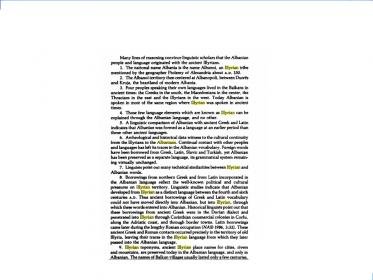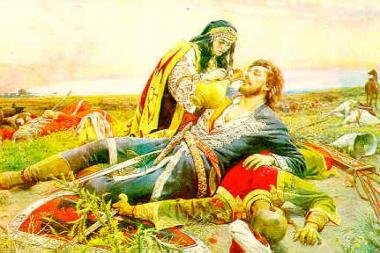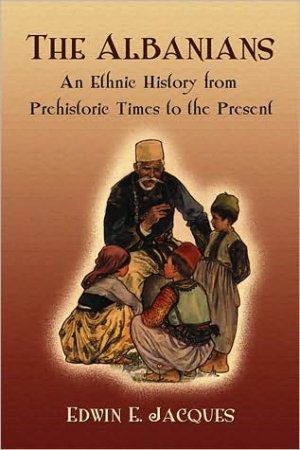Titulli: Albanologu Edwin E. Jacques.
Albanian leadership in the Unification of Italy (1860-1871)
Edwin Jacques - "The Albanians"
As in Greece, so in Italy the descendants of the Arbëreshë refugees made significant contributions to the unification of their adopted land (1860-1871). Among the earliest and most active centers of the revolution was their village of Hora e Arbëreshëvet near Palermo, usually abbreviated to Hora; this was commonly known to Italians as Piana dei Greci, later Piana degli Albanesi.
While Garibaldi, who came from Albanian stock, was pondering how and where to begin the struggle to free Italians from Bourbon oppression and unite them in a single state, an Arbëreshë çeta of 400 fighters from Hora attacked the Bourbon troops in April 1860. Francesco Crispi, also an Arbëreshë from Sicily, who signed himself an “Albanian by blood and by heart” (Fashizmi 13 February 1940; Drita 28 November 1937, 11), was Garibaldi’s closest advisor and the political brain of his expedition. It was Crispi who persuaded Garibaldi to sail from Genoa for Sicily that 6 May with his famous “One Thousand” fighters.
Of these the historian Xoxi names six men besides Crispi who were former students of the Arbëreshë college of San Demetrio Corone in Calabria, southern Italy (NAlb 1985, 3:23). One of these was Domenic Mauro, born of Albanian parentage in 1812, who became a celebrated poet and author. But when popular uprisings against social injustice began, he forsook the pen for the sword and fought bravely under Garibaldi.
In fact, an Italian professor, Rosolino Petrotta, in his series “Shqiptarët në Itali” (Albanians in Italy) (Fashizmi 13 Feb. 1940), has listed 19 Italo-Albanian patriots from Hora alone who became prominent in the uprisings of 1860. Petrotta pointed out too that Garibaldi himself did not overlook this heroism, but on 2 October 1860 had declared publicly, “Gli albanesi sono eroi che si sono distinti in tutte le lotte contro la tirannide” (The Albanians are heroes who have distinguished themselves in all the wars against tyranny).
Still cherishing their Albanian ethnicity, these Arbëreshë fighters of Hora were characterized in these words by Italian chronicler Aba with the Garibaldi expedition: “They are proud and honest people, they are proud of their origin. In their songs they keep alive the feeling of four centuries, and still dream that one day their kin will be able to return to their distant ancestral Homeland” (NAlb 1985, 3:23).
The courageous support of the many Arbëreshë patriots helped Garibaldi to quickly subdue the island, and when he crossed over to southern Italy, the fighting Arbëreshë of that region welcomed him with indescribable joy. Italy as a united nation owes much to the descendants of those Albanian refugees. It must be remembered that one of them, Francesco Crispi, would serve twice as prime minister of Italy (1887-1891 and 1893-1896).
Two distinguished literary figures must also be noted. Girolamo (or Jeronim) De Rada (1814-1903), one of the greatest Albanian poets, was born at Macchia near Cosenza in southern Italy. Equally outstanding was the poet Giuseppe Skiro (1865-1927), who came from Albanian stock at Hora of Palermo and who is considered De Rada’s direct successor. Beginning about 1861 thousands of these Sicilian Arbëreshi sought a new life in the New World, many going to New Orleans. Their story is told by Bret Clesi in his ‘The Arbëreshë and Contessa Entellina” (Liria 1 March 1984, 4).
In 1901 the Arbëreshë of southern Italy were reported to have 80 towns, 27 of the Greek rite (Uniat churches related to Rome), and 53 of the Latin or Roman Catholic rite, with a total population of 208,410 persons (Barbarich 1905, 331-33). Arbëreshë towns were distributed as follows in the southern Italian provinces: Catanzaro 13, Cosenza 29, Campobasso 7, Lecce 10, Foggia 7, Potenza 5, Palermo 5 and Catania 3 (Dituria 1 June 1909, 83-85).
Currently, Mahir Domi in his statistical study of “Albanian Settlements in the World” (Liria 28 March 1980, 3) estimates that about 136,000 of these Arbëreshë people in 55 villages still speak Albanian, whereas about 182,000 Arbëreshë in other villages can no longer speak it. Eqrem اabej, in his ‘The World of the Arbëreshi” (NAlb 1987, 6:28), observed that those living in mountainous regions seem to have retained their language and culture better than those living in open country. Yet it seems remarkable that after 500 years in Italy, so many Arbëreshë living in their compact Albanian communities have not been altogether assimilated. Customs, costumes, poems, songs and traditions have been passed down from mother to child for generations, using their Arbëreshë dialect of the Albanian language. Five hundred years after their departure from the homeland an Arbëreshë daughter now living in the United States quoted in quite understandable Albanian a nostalgic song they traditionally sang as they left their church in Italy. Turning to the East toward the homeland they would sing, “Motherland, place of beauty, / I have left, never again to see you./ Over there I have left my father, / Over there I have left my mother, / Over there I have left my brother. . . /1 have left, never to see you again” (ACB 1985, 18-19).
Their language and traditions have also been perpetuated in their own newspapers and publications. One of their number, Prof. Francesco Solano, presently holds the chair of Albanian language and literature at the University of Cosenza, usually writing under the pen name Dushko Vetmo. Here it was reported recently that many of the town halls still bear the official emblem of the black two-headed eagle of Skanderbeg (Fashizmi 9 February 1940).
Resisting denationalization, another reported that “even on the bottles of wine we produce in our villages, we have the figure of Skanderbeg on the labels” (Liria 16 May 1980, 4). In 1983 the Albanian government recognized this heritage and presented a bust of the national hero for the Skanderbeg Square of Spezzano Albanese (ibid.). Another such bust was erected in the Arbëreshë community of San Nicola del Alto of Catanzaro (Liria 1 May 1984, 1). In just such communities as these did the many Italo-Albanians preserve their love for the old homeland while yet making their distinct contribution to the new.




